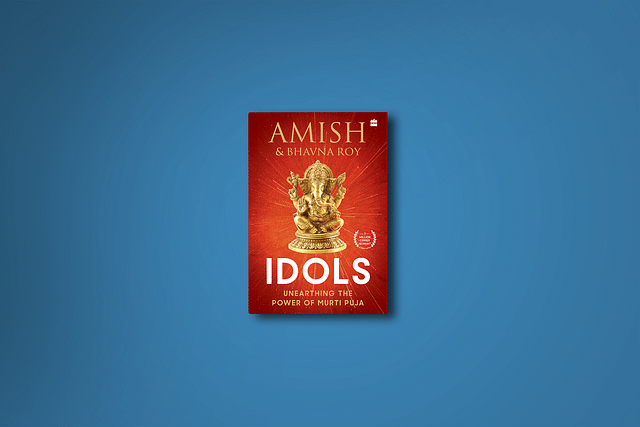Books
In Defence Of Devotion: Amish and Bhavna Roy's 'Idols' Tackles Ridicule of Idol-Worship
Bibek Debroy
Nov 16, 2023, 05:20 PM | Updated 08:43 PM IST
Save & read from anywhere!
Bookmark stories for easy access on any device or the Swarajya app.

Idols: Unearthing the Power of Murti Puja. Amish and Bhavna Roy. HarperCollins India. 2023. Pages 271. Rs 339.
Amish Tripathi is a famous and best-selling author. But he doesn’t write only fiction.
With his sister, Bhavna Roy, he has started a series of explorations on Hindu dharma.
Dharma: Decoding the Epics for a Meaningful Life (2020) was the first. One shouldn’t call this a sequel, since these are independent books.
This one is titled, Idols, Unearthing the Power of Murti Puja and the second part of the title explains what the book is about.
The book is written in a usual style, that of conversations between people. A few quotes from these conversations will explain the background.
“Europeans, Turks and many others went to great lengths to forcibly end idol worship. In their view, it was genuinely “satanic”, as bizarre as that sounds to us. There was a massive effort to purge idol worship throughout the world. Temples were destroyed or appropriated. So many idol-worshipping cultures — the Hellenic, the Khemic, the Mesopotamian —were almost completely annihilated. They only exist in museums now.” (p.30)
“Such behaviour seems to be sanctioned in the Bible itself, in the Old Testament.” (p.33)
This leads to a stronger proposition.
“It’s interesting though, that while there are so many examples of idol-rejecting cultures massacring idol-worshipping “others”, there are no historical instances that I am aware of, of idol-worshipping cultures going around killing others simply because they did not worship idols.” (p.39)
That stronger proposition is essentially an empirical one, but is also predicated on idol-worshipping cultures being more tolerant and open-minded.
“Theological liberalism is one of the innate strengths of idol-worshipping cultures.” (p.286)
Hinduism and sanatana dharma have been under attack for thousands of years and there is no let-up, even in the present.
Criticism, unless it is motivated, comes from an inability to understand sanatana Hindu dharma, since it doesn’t come with a ready set of commandments about what to do and what not to do.
There are many strands to that critique. But one of those has always been idol-worship, or murti puja.
“Yet, like battered wives, there are many idol-worshippers today who blame themselves, rather than those who oppressed their ancestors.” (Page 18)
“We need to point out, calmly but forthrightly, that the framing of the debate, as idol-worshipping being ‘wrong’, is itself erroneous.” (p.xx)
This explains the objective and content of this book, developed over 16 chapters.
There is a famous anecdote about Swami Vivekananda and Mangal Singh, the king of Alwar, when Swami Vivekananda visited Alwar in 1891. Anyone familiar with Swami Vivekananda’s life will know about this. Here is the incident, as stated in Swami Nikhilananda’s biography of Swami Vivekananda.
“He had a sharp exchange of words with the Maharaja, who was Westernized in his outlook….Next, the Maharaja ridiculed the worship of images, which to him were nothing but figures of stone, clay, or metal. The Swami tried in vain to explain to him that Hindus worshipped God alone, using the images as symbols. The Prince was not convinced. Thereupon the Swami asked the Prime Minister to take down a picture of the Maharaja, hanging on the wall, and spit on it. Everyone present was horror-struck at this effrontery. The Swami turned to the Prince and said that though the picture was not the Maharaja himself, in flesh and blood, yet it reminded everyone of his person and thus was held in high respect; likewise the image brought to the devotee's mind the presence of the Deity and was therefore helpful for concentration, especially at the beginning of his spiritual life. The Maharaja apologized to Swamiji for his rudeness.”
There are many Mangal Singhs even today and Amish and Bhavna Roy’s book is directed towards them. More accurately, it is directed towards those who have to defend themselves against such Mangal Singhs.
In the process, as is inevitable, the authors move beyond the narrow terrain of murti puja and explore other aspects of Hinduism. Written in a popular and reader-friendly way, this is a worthwhile attempt.
However, there are two reasons why I am sceptical. First, there is a question of the style.
“This book is structured as conversations, drawing inspiration from the ancient Indian Upanishadic traditions and the Greek Socratic Dialogues authored by his student, Plato. We find that conversations are a much better way to explain complex concepts than the relatively modern Western approach of a non-fiction book, which ends up being rather textbook-ish.” (p.xxi)
The idea of personalisation, as opposed to a dry, didactic and pedantic book, is a good idea. But with multiple protagonists in this volume, the intended dialogue becomes a multilogue and I don’t think it has worked.
Second, who is the target audience? At least for Amish’s fiction, the readers are young, probably a generation that doesn’t have time to read, delve and contemplate.
Perhaps with that target audience in mind, this book doesn’t probe beyond the superficial. It skims the surface, which may very well be the intended objective. But the relatively ignorant reader will at least learn something.
Save & read from anywhere!
Bookmark stories for easy access on any device or the Swarajya app.
Bibek Debroy is a noted Economist. His 10-volume translation of The Mahabharata is one of the most seminal works in contemporary Indology. He was a member of the Swarajya Advisory Board.
Support Swarajya's 50 Ground Reports Project & Sponsor A Story
Every general election Swarajya does a 50 ground reports project.
Aimed only at serious readers and those who appreciate the nuances of political undercurrents, the project provides a sense of India's electoral landscape. As you know, these reports are produced after considerable investment of travel, time and effort on the ground.
This time too we've kicked off the project in style and have covered over 30 constituencies already. If you're someone who appreciates such work and have enjoyed our coverage please consider sponsoring a ground report for just Rs 2999 to Rs 19,999 - it goes a long way in helping us produce more quality reportage.
You can also back this project by becoming a subscriber for as little as Rs 999 - so do click on this links and choose a plan that suits you and back us.
Click below to contribute.





